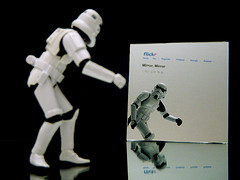
Image source: Life Online by
Kalexanderson (CC BY-NC-SA 2.0)
There are plenty of ways in which we can support and encourage students to participate in online activities, and these are important when designing activities for students who study online and at a distance.
This report from Faculty Focus on ‘Eight Roles of an Effective Online Teacher’ has some important considerations for us all. When looking at the differences between campus based face-to-face teaching and online distance teaching it is as different as riding a motorcycle and driving a car: yes, they are both methods of transport, they both use the same roads and infrastructure, but they require different training and vastly different levels of competencies to be safe at either of them.
The Faculty Focus report highlights eight roles that you ought to consider to be an effective online teacher. These are:
Tour Guide: An online teacher acts in a similar way to a holiday tour guide, leading their students through a series of places, themes, projects, learning experiences, etc. If planned and implemented properly these ‘stops’ will enable the teacher to dedicate time to teaching and not guiding and redirecting, their students towards the concepts or theories they’ve strayed from or missed.
Cheerleader: Everyone needs some encouragement at some point, and this is even more important for students studying at a distance: they need to know they are not as isolated , confused, or ignored as they may feel. An effective online teacher will make the effort makes intentional efforts to communicate specific encouraging messages to individual learners and they will make “intentional efforts to communicate specific encouraging messages to individual learners and the group as a whole.”
Role Model / Coach: A role model or coach put the learners in a place of security and encouragement whilst leaving room for students to find their way, make mistakes (and learn from them), improve, grow, and achieve. A teacher, in the role of coach, finds a way “to hand the subject over to the students to do something with” from whatever approach is appropriate to the learning, topic, cohort of students, etc.

Image source: Mirror Mirror by
JD Hancock (CC BY 2.0)
Mirror: Being able to reflect on your own work and learning is important, and just as important is the ability to check their progress and learning with feedback and support. How are they doing, are they reaching the goals or learning objectives, do they need to do more? By providing them with a ‘mirror’ you give them an avenue to find this out, to get some kind of feedback.
Butterfly: Don’t let your learners languish on their own with their lonely online learning experience: the online teacher needs to flit between channels, discussions, learner/teacher relationship to encourage and entertain, but to maintain engagement and learning.
Big Brother: “Everything is documented in an online course”. Statistical analysis of times and numbers of access, pages, contributions, who is and isn’t engaging, etc. can have an impact on progress and be used to update or modify learning activities and the general approach used with students.
Valve Control: Students can, and do, get lost among the noise and content. By releasing content in a controlled ‘chunk’-like way the learners will have access to the materials they need, at that time, for a specific purpose. A time-release on materials will stop learners getting lost in the volume of work to do, and enable them to focus on the here and now for a specific learning outcome.
Co-learner: “Great teachers are lifelong learners, and they can model that learning for their students in a variety of ways in the online classroom. The teacher can be an active (but not too active or it will silence students) participant in online discussions, sharing what they are learning about the subject, and even complete all or parts of some assignments, sharing their work with the students. This goes a long way in building a vibrant and dynamic online learning community where every person in the community commits to embodying the traits of a lifelong learner.”


 Subscribe to David Hopkins's posts
Subscribe to David Hopkins's posts
Recent Comments